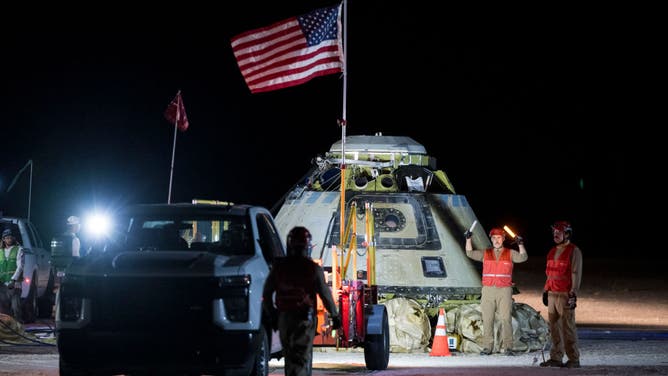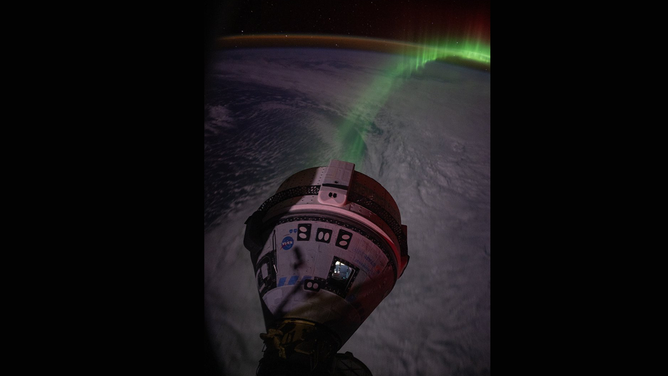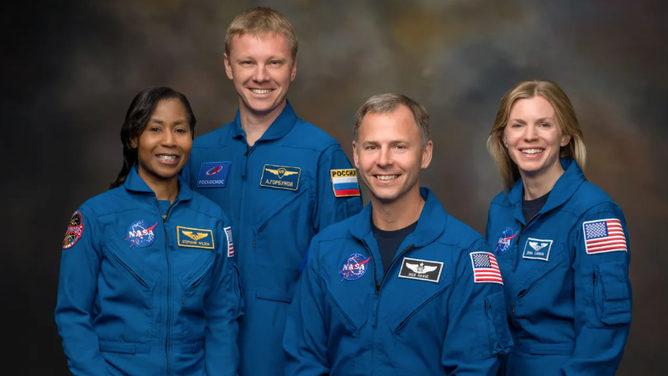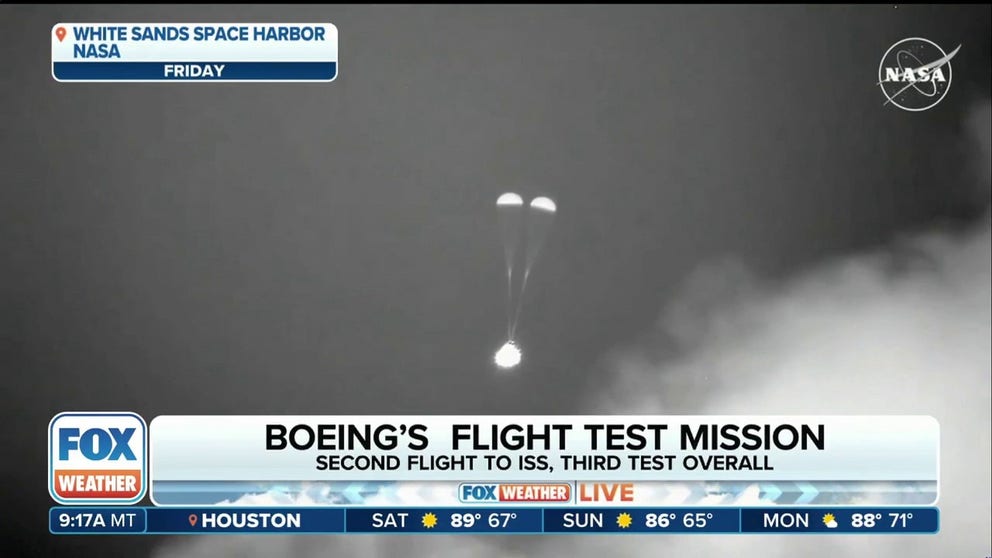Boeing Starliner returns home to Earth without astronauts, marking end of tumultuous mission
The module parachuted down to the designated landing site in White Sands, New Mexico just after 10 p.m. Mountain Time after a six-hour autonomous flight home from the International Space Station.
Boeing Starliner returns safely to Earth Friday night
Boeing's troubled Starliner spacecraft successfully returned home to Earth Friday night without astronauts, marking the end of the tumultuous journey that turned from an eight-day test mission into a three-month odyssey that left two NASA astronauts with an extended and unplanned stay in space
WHITE SANDS, N.M. — Boeing's troubled Starliner spacecraft successfully returned home to Earth Friday night without astronauts, marking the end of the tumultuous journey that turned from an eight-day test mission into a three-month odyssey that left two NASA astronauts with an extended and unplanned stay in space.
The module parachuted down to the designated landing site in White Sands, New Mexico just after 10 p.m. Mountain Time after a six-hour autonomous flight home from the International Space Station.

NASA and Boeing welcomed Starliner back to Earth at 12:01am ET on Saturday, Sept. 7, following the uncrewed spacecraft's landing in New Mexico.
(NASA)
NASA started the process to bring home an empty Boeing Starliner spacecraft home on Friday evening with a successful undocking procedure, concluding the vehicle’s first test flight with astronauts plagued by problems with helium leaks and reaction control thrusters that started before the spacecraft left Earth.
From 8 day to 9 month mission in space
The Starliner arrived at the ISS in early June with NASA astronauts Butch Wilmore and Suni Williams as part of Boeing’s crew flight test to certify the spacecraft to fly future human missions.
Williams and Wilmore launched from Florida in June on what was to be an 8-day mission, but due to the current situation with Starliner, they will spend nearly nine months in space. They will remain in orbit until their new ride home with SpaceX arrives.

This handout image supplied by NASA shows Boeing and NASA teams work around NASA's Boeing Crew Flight Test Starliner spacecraft after it landed uncrewed at White Sands Space Harbor, on September 6, 2024 at White Sands, New Mexico.
(Photo by Aubrey Gemignani/NASA / Getty Images)
Over the summer, NASA managers refuted claims that the veteran astronauts were "stranded in space." NASA's Commercial Crew Program Manager Steve Stich maintained this sentiment on Wednesday.
SOURCE OF ‘STRANGE’ SOUNDS FROM BOEING STARLINER IDENTIFIED
"They were never stuck or stranded; they always had a way to depart the space station," Stich said.
New seats, new suits, new spacecraft
This week, Williams and Wilmore are preparing their spacecraft to return home without them. Williams, who was first assigned to fly Starliner in 2018, named the spacecraft Calypso after oceanographer Jacques Cousteau's research ship.
Boeing's Starliner spacecraft departs the International Space Station
NASA started the process to bring home an empty Boeing Starliner spacecraft home on Friday, concluding the vehicle’s first test flight with astronauts plagued by problems that started before the spacecraft left Earth.
On Wednesday, Williams said it was "bittersweet" packing up the Starliner in a conversation with Neal Nagata, who serves as capsule communication for the crew on the ground at mission control in Houston.
"We want to do the best to make sure she's in good shape," Williams said in ISS audio, adding, "Thanks for backing us up. Thanks for looking over our shoulder and making sure we got everything right in place because we want to have a nice landing in the desert."

NASA astronauts Butch Wilmore, left, and Suni Williams, wearing Boeing spacesuits, are seen as they prepare to depart the Neil A. Armstrong Operations and Checkout Building for Launch Complex 41 on Cape Canaveral Space Force Station to board the Boeing CST-100 Starliner spacecraft for the Crew Flight Test launch, Wednesday, June 5, 2024, at NASA’s Kennedy Space Center in Florida. Photo Credit: (NASA/Joel Kowsky)
(NASA)
Starliner leaving the astronauts in space led to many behind-the-scenes problem-solving for NASA, Boeing, and SpaceX teams. This required a new game plan for spacesuits, spacecraft configuration and kicking two astronauts off the upcoming Crew-9 launch.
NASA and Boeing have maintained that, despite the issues with Starliner, it would have been safe to bring the astronauts back to Earth during an emergency. Now that Starliner is gone, the SpaceX Crew Dragon spacecraft that carried the Crew-8 mission astronauts to the ISS will serve as their lifeboat in an emergency.
The astronauts moved the cargo pallet on Dragon to make room for the Starliner’s astronauts if they needed to depart the ISS urgently. However, the Starliner spacesuits Williams and Wilmore wore on their journey up are incompatible with the SpaceX vehicle or the temporary configuration on the Crew-8 vehicle.

A view of Boeing's Starliner spacecraft as seen from the SpaceX Crew Dragon docked at the space station with a view of aurora lights above Earth.
(Matthew Dominick/NASA)
Wilmore and Williams will remain on the space station until February 2025, when they return to Earth on SpaceX's Dragon spacecraft. They will be joined by two astronauts on NASA’s SpaceX Crew-9 mission, which is set to launch later this month. The astronauts will wear compatible suits for their return flight. The Crew-9 mission will also fly an additional SpaceX spacesuit. Another SpaceX spacesuit was launched on a recent cargo supply mission to the ISS.
"The way the Dragon is configured, for an emergency, Butch and Suni riding on the cargo pallet in those temporary seats that I described. But that's an unsuited configuration, so there's no spacesuits that work there," Stich said. "The Dragon's configured to support four suits and four people with suits."
To make room on the incoming Crew-9 Dragon spacecraft, NASA opted to launch NASA astronaut Nike Hague and Russian Cosmonaut Aleksandr Gorbunov and leave two seats open for Wilmore and Williams. NASA astronauts Zena Cardman and Stephanie Wilson were bumped from the Crew-9 mission and could fly on a future mission.

Official NASA’s SpaceX Crew-9 portraits with Zena Cardman, Nick Hague, Stephanie Wilson and Aleksandr Gorbunov. NASA announced in late August that Wilson and Cardman will remain on Earth to make room on SpaceX's Dragon to bring home NASA astronauts Butch Wilmore and Suni Williams.
(NASA)
When Starliner is back on Earth, engineers will continue trying to understand the issues the spacecraft experienced in orbit.
"Many things on the vehicle are working really well," Stich said. "What we really need to go do is look at the things that didn't perform the way we expected. Like I talked about the helium leaks. Can we go fix those leaks? Test those on the ground and have confidence to move forward and fly again."
Stich said NASA is still working toward launching astronauts on Starliner again next year.
Boeing's Starliner crew flight test came 10 years after NASA awarded contacts to both SpaceX and Boeing. Both companies completed uncrewed flight tests before launching humans to the ISS, but Boeing's first attempt in 2019 did not make it to the space station, requiring the company to conduct a second attempt in 2022.
When SpaceX launches the Crew-9 mission later this month, it will be the company's 10th flight with NASA astronauts.
Meanwhile, Starliner will now head back to NASA's Kennedy Space Center in Florida where a Boeing team will now pore over the mission data.
"I want to recognize the work the Starliner teams did to ensure a successful and safe undocking, deorbit, re-entry and landing," Mark Nappi, vice president and program manager of Boeing’s Commercial Crew Program, said in a statement after Starliner landed Friday night. "We will review the data and determine the next steps for the program."

